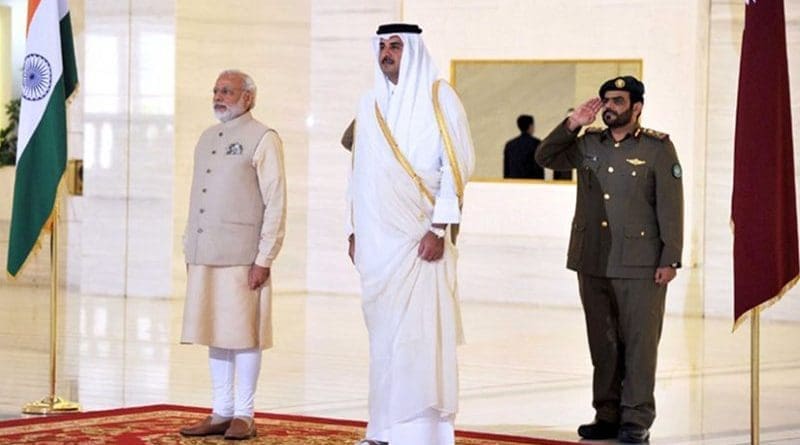The Gulf Crisis: Why Is India Still Neutral? – OpEd
By Arab News
By Dr. Naser Al-Tamimi*
The decision by four Arab states — Saudi Arabia, the UAE, Bahrain and Egypt — to cut ties with Qatar may have ramifications on India. For now, these will be mostly concentrated in the diplomatic sphere; however, pressure on New Delhi to pick sides is likely to grow as the Gulf crisis deepens.
So far, India has been working hard to maintain a neutral stance over the Gulf crisis to avoid any political and economic risks and ensure the well-being of Indian citizens working or living in the Gulf Cooperation Council (GCC) states. Certainly, India is watching the situation very closely as it has even more reason to be concerned about the developments in the Gulf region.
The Gulf states are among the most vital economic zones for India. Indeed, the GCC bloc was India’s largest trading partner in 2016. At the country level, the UAE and Saudi Arabia were among New Delhi’s Top 5 trading partners.
The GCC is also the second top destination, after the US, for Indian products. The six Arab Gulf countries — Bahrain, Kuwait, Oman, Qatar, Saudi Arabia and the UAE — collectively received about 86 percent of total Indian goods destined for the Middle East, or nearly 16 percent (almost $41 billion) of India’s total exports in 2016, according to International Monetary Fund (IMF).
Thus, if the crisis escalates amid continued decline in oil prices and low economic growth, this may adversely affect the demand for Indian goods.
Energy independence
Energy is another critical area of growing ties between India and the GCC states. India is the third largest oil consumer in the world (after the US and China), as well as the third largest oil importer, according to the International Energy Agency (IEA).
At present, a third of India’s crude imports, and about two-thirds of liquefied natural gas (LNG) imports, comes from the GCC. In 2016, Saudi Arabia was the largest oil supplier, providing India with almost 19 percent of its crude needs. Qatar was the top exporter of LNG, with its share hitting almost 62 percent of India’s total LNG imports last year.
Looking forward, India’s oil imports are expected to increase by more than 1 million barrels per day (bpd) over the next decade. With expectations of rising demand, a group of Indian state petroleum firms plan to build a 60 million tons/year (1.2 million bpd) mega-refinery comprising three 20 million tons a year (400,000 bpd) crude distillation units (CDUs). As a result, the Indian government is encouraging Saudi Aramco and other GCC companies to buy stakes in these projects.
Importantly, India is at risk of growing environmental problems. Many of its major cities have heavily polluted air and rivers, raising questions about the sustainability of the economy’s rapid growth. Thus, New Delhi is looking to increase the share of natural gas in the country’s energy mix.
In this regard, India’s natural gas import needs are projected to more than double over the next decade. Its imports are expected to increase from 26.8 billion cubic meters (bcm) in 2016 to around 57 bcm by 2026, mainly in the form of LNG, as gas pipelines from Iran or Turkmenistan became distant dream, according to BMI Research.
New Delhi is seeking Qatari investment in its power plants in return for long-term LNG supply contracts commitment. India’s Petronet already buys 8.5 million tons a year of LNG from Qatar under three long-term contracts, which expire in 2028-2029.
Consequently, the stability of the Gulf region is vital to India to ensure the flow of energy imports. Any escalation in the Gulf could lead to higher energy prices, and subsequently increase the financial burden on the Indian budget. To be sure, New Delhi’s energy imports bill (excluding petrochemicals and fertilizers) hit more than $89 billion (36 percent from the GCC states) in 2016, although it has almost halved since the decline in oil prices.
Financial stakes
Meanwhile, there are around 4-5 million people (650,000-700,000 in Qatar alone) of Indian origin working in the GCC countries. These Indian workers in the GCC states send remittances every year worth tens of billions of dollars, which are very important New Delhi’s public finance.
A prolonged crisis or uncertainty could increase insecurity, dampen economic sentiment and ultimately may lead to more Indian layoffs and thus a decline in remittances.
India also ranked fifth in the list of the largest investors in the GCC, with investments exceeding $2.5 billion, representing more than 8 percent of total foreign investments in the GCC in 2016. Between 2010 and 2016, the GCC attracted $199 billion in foreign investment, with India accounting for $21.1 billion or 11 percent of that, ranking it third after the US and UAE, according to the Arab Investment & Export Credit Guarantee Corporation.
Given India’s strategic interests and growing ties with all GCC states, New Delhi has rightly taken a neutral position over the Gulf diplomatic crisis, calling the concerned countries to resolve it peacefully and through dialogue. Indeed, as there is not much to be gained by getting too involved in the GCC dispute; it is logical to expect India to maintain its present cautious and balanced approach.
• Dr. Naser Al-Tamimi is a UK-based Middle East researcher, political analyst and commentator with interests in energy politics and Gulf-Asia relations. Al-Tamimi is author of the book “China-Saudi Arabia Relations, 1990-2012: Marriage of Convenience or Strategic Alliance?” He can be reached on Twitter @nasertamimi and e-mail: [email protected].

